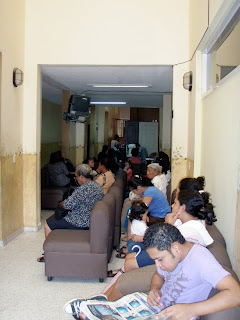
ZOE - pronounced SO-eh: Greek origin meaning “life.” Also used in the bible in reference to eternal life.
Clinica Zoe is associated with the Protestant church Vida Abundante (the abundant life), a large church here in Honduras which funds several social projects from Zoe to orphanages.

The clinic is able to provide a multitude of services, from OBGYN and orthodontia to ENT and optometry/ophthalmology at very low cost to patients. For example, an optometry appointment costs 140 Lempiras - about $8, and an ophthalmology appointment is only 170 Lemps - less than $10. Because of this, we serve the poor of not only Tegucigalpa, but also those that make the journey from up to 6 hours away.

<----- [Ramon, age 90. Diet: Vegan] [ A true campesino, he still walks independently]
We see all ages, from babies to 90 year olds and beyond. One of my favorite parts of existing in the clinic is seeing the families and friends that pass through together. Nearly all of the patients are accompanied by a family member - a child, a parent, a cousin, an aunt. Some are supported by canes, others by family, while still others are mobile without help. The near-blind usually rest a hand on their son or daughter’s shoulder as
 they make their way through the crowded hallway. They all carry themselves deliberately, with pride, and wait patiently for their turn. When it comes time for autorefracting and visual acuity, the accompanying family or spouse stands nearby in case the they need to help explain something or physically support their loved one.
they make their way through the crowded hallway. They all carry themselves deliberately, with pride, and wait patiently for their turn. When it comes time for autorefracting and visual acuity, the accompanying family or spouse stands nearby in case the they need to help explain something or physically support their loved one.[mother and daughter at the autorefractor]

Life at Clínica Zoe starts around 6:45 in the morning, when the night guard opens the ecru-colored gate into the courtyard of the clinic. Patients line up at the door until 7 AM when Kenya, the receptionist, opens the door and corrals the flood of patients from her desk to the Caja (cashier) operated by Rosi. Rosi runs a tight ship with a quick wit and can arm wrestle any man in the clinic, needless to say I admire her. After passing through Rosi with their recibo (receipt) in hand, the patients enter pre-clinic and the waiting area where we, the volunteers, and the clinic techs perform basic exams with the autorefractor and visual acuity. [performing visual acuity exam]

After acuity and autorefracting, the patients sometimes wait hours to see an optometrist or ophthalmologist, without a single word of complaint or hurry. If only patients in the States could see it, they most likely would still not believe it. Truly, the pace of life here is much slower - and much more my style.
[The covered part of the courtyard, enjoying lunch] ------>
















